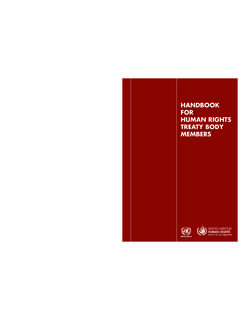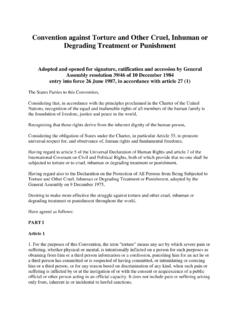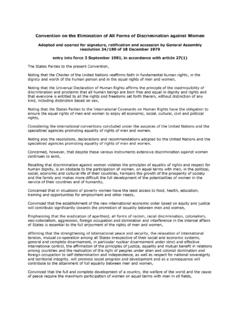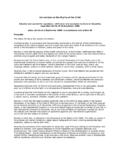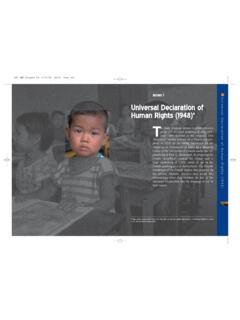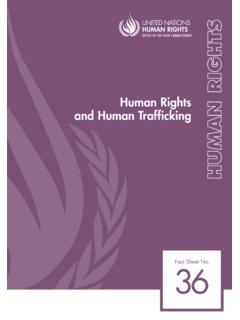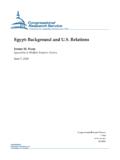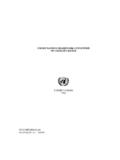Transcription of Women s Rights are Human Rights Women s Rights are
1 Women 's Rights are Human Rights Women 's Rights are Human Designed and Printed at United Nations, Geneva 1404379 (E) November 2014 3,350 HR/PUB/14/2. United Nations publication Sales No. ISBN 978-92-1-154206-2. Rights i Women 's Rights are Human Rights New York and Geneva, 2014. Women 'S Rights ARE Human Rights . NOTE. The designations employed and the presentation of the material in this publication do not imply the expression of any opinion whatsoever on the part of the Secretariat of the United Nations concerning the legal status of any country, territory, city or area, or of its authorities, or concerning the delimitation of its frontiers or boundaries. Symbols of United Nations documents are composed of capital letters combined with figures. Mention of such a figure indicates a reference to a United Nations document.
2 HR/PUB/14/2. UNITED NATIONS PUBLICATION. SALES NO. ISBN 978-92-1-154206-6. E-ISBN 978-92-1-056789-3. 2014 UNITED NATIONS. ALL WORLDWIDE Rights RESERVED. iii CONTENTS. 1. I. PROTECTION OF THE Human Rights OF Women UNDER. INTERNATIONAL 3. A. International Human Rights 4. B. Regional 7. II. GLOBAL 11. A. Vienna Declaration and Programme of 12. B. International Conference on Population and 12. C. Beijing Declaration and Platform for 13. D. Millennium Development 14. E. United Nations Conference on Sustainable 15. III. UNITED NATIONS 19. A. The Human Rights Council and its 19. B. The Security 21. C. The Commission on the Status of 21. IV. KEY 25. A. The public-private 26. B. Universality of Human 27. C. Non-discrimination and equality between Women and 29. D. Equality and 33. E. 35. F. Intersectionality and multiple forms of 37.
3 Iv Women 'S Rights ARE Human Rights . V. THE Human Rights FRAMEWORK IN 41. A. Women 's Rights in public and political 43. B. Sexual and reproductive health and 50. C. Women 's right to an adequate standard of 62. D. Violence against 73. E. Impact of migration and displacement on the enjoyment of Women 's 86. F. Women 's Human Rights in conflicts and crises .. 92. G. Women 's access to 109. 1. INTRODUCTION. Attaining equality between Women and men and eliminating all forms of discrimination against Women are fundamental Human Rights and United Nations values. Women around the world nevertheless regularly suffer violations of their Human Rights throughout their lives, and realizing Women 's Human Rights has not always been a priority. Achieving equality between Women and men requires a comprehensive understanding of the ways in which Women experience discrimination and are denied equality so as to develop appropriate strategies to eliminate such discrimination.
4 The United Nations has a long history of addressing Women 's Human Rights and much progress has been made in securing Women 's Rights across the world in recent decades. However, important gaps remain and Women 's realities are constantly changing, with new manifestations of discrimination against them regularly emerging. Some groups of Women face additional forms of discrimination based on their age, ethnicity, nationality, religion, health status, marital status, education, disability and socioeconomic status, among other grounds. These intersecting forms of discrimination must be taken into account when developing measures and responses to combat discrimination against Women . This publication provides an introduction to Women 's Human Rights , beginning with the main provisions in international Human Rights law and going on to explain particularly relevant concepts for fully understanding Women 's Human Rights .
5 Finally, selected areas of Women 's Human Rights are examined together with information on the main work of United Nations Human Rights mechanisms and others pertaining to these topics. The aim of the publication is to offer a basic understanding of the Human Rights of Women as a whole, but because of the wide variety of issues relevant to Women 's Human Rights , it should not be considered exhaustive. I. 3. Protection of the Human Rights of Women under international law Since the founding of the United Nations, equality between men and Women has been among the most fundamental guarantees of Human Rights . Adopted in 1945, the Charter of the United Nations sets out as one of its goals to reaffirm faith in fundamental Human Rights , in the dignity and worth of the Human person, [and] in the equal Rights of men and Women .
6 Furthermore, Article 1 of the Charter stipulates that one of the purposes of the United Nations is to promote respect for Human Rights and fundamental freedoms without distinction as to race, sex, language or religion . This prohibition of discrimination based on sex is repeated in its Articles 13 (mandate of the General Assembly) and 55 (promotion of universal Human Rights ). In 1948, the Universal Declaration of Human Rights was adopted. It, too, proclaimed the equal entitlements of Women and men to the Rights contained in it, without distinction of any kind, such as .. sex, . In drafting the Declaration, there was considerable discussion about the use 4 Women 'S Rights ARE Human Rights . of the term all men rather than a gender-neutral The Declaration was eventually adopted using the terms all Human beings and everyone.
7 In order to leave no doubt that the Universal Declaration was intended for everyone, men and Women alike. A. INTERNATIONAL Human Rights INSTRUMENTS. After the adoption of the Universal Declaration, the Commission on Human Rights began drafting two Human Rights treaties, the International Covenant on Civil and Political Rights and the International Covenant on Economic, Social and Cultural Rights . Together with the Universal Declaration, these make up the International Bill of Human Rights . The provisions of the two Covenants, as well as other Human Rights treaties, are legally binding on the States that ratify or accede to them. States that ratify these treaties periodically report to bodies of experts, which issue recommendations on the steps required to meet the obligations laid out in the treaties. These treaty - monitoring bodies also provide authoritative interpretations of the treaties and, if States have agreed, they also consider individual complaints of alleged Both Covenants use the same wording to prohibit discrimination based on, inter alia, sex (art.)
8 2), as well as to ensure the equal right of men and Women to the enjoyment of all Rights contained in them (art. 3). The International Covenant on Civil and Political Rights guarantees, among other Rights , the right to life, freedom from torture, freedom from slavery, the right to liberty and security of the person, Rights relating to due process in criminal and legal proceedings, equality before the law, freedom of movement, freedom of thought, conscience and religion, freedom of association, Rights relating to family life and children, Rights relating to citizenship and political participation, and minority groups' Rights to their culture, religion and language. The International Covenant on Economic, 1. Johannes Morsink, Women 's Rights in the Universal Declaration , Human Rights Quarterly, vol. 13, No. 2 (May 1991).
9 2. For more information on the Human Rights treaty system, see OHCHR, Fact Sheet No. 30: The United Nations Human Rights treaty System and OHCHR, Fact Sheet No. 7: Individual Complaint Procedures under the United Nations Human Rights Treaties. I. PROTECTION OF THE Human Rights OF Women UNDER INTERNATIONAL LAW 5. Social and Cultural Rights guarantees, for instance, the right to work, the right to form trade unions, Rights relating to marriage, maternity and child protection, the right to an adequate standard of living, the right to health, the right to education, and Rights relating to culture and science. In 1967, United Nations Member States adopted the Declaration on the Elimination of Discrimination against Women , which states that discrimination against Women is an offence against Human dignity and calls on States to abolish existing laws, customs, regulations and practices which are discriminatory against Women , and to establish adequate legal protection for equal Rights of men and Women .
10 Less than a year later a proposal for a legally binding treaty on Women 's Rights was made. The Convention on the Elimination of All Forms of Discrimination against Women was adopted by the General Assembly in 1979. Its preamble explains that, despite the existence of other instruments, Women still do not enjoy equal Rights with men. The Convention articulates the nature and meaning of sex-based discrimination, and lays out State obligations to eliminate discrimination and achieve substantive equality. As with all Human Rights treaties, only States incur obligations through ratification. However, the Convention articulates State obligations to address not only discriminatory laws, but also practices and customs, and discrimination against Women by private actors. With these general principles as an overarching framework, the specific obligations of States to eliminate discrimination against Women in political, social, economic and cultural fields are laid out in 16 substantive articles.

